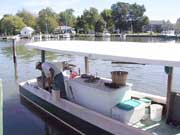 |
Crab Catch
by M.L. Faunce |
 Misery at the Gas Pumps Isn’t Just on the Roads
Misery at the Gas Pumps Isn’t Just on the Roads
Will gasoline prices keep crabbers at the docks?
Americans don’t seem ready to give up their love affair with the automobile in spite of soaring gasoline prices. For boaters, it’s another thing. Brandon Miller, general manager at Skipper’s Pier Restaurant and Fuel Dock in Deale, says “people are complaining about prices, but it’s a universal complaint. But the several other fuel docks within a few miles are staying competitive, so “there’s no where else to go for cheaper gas.”
So, he adds, “they’re spending less, filling up just a quarter or half tank, not topping off.”
Unlike the rest of us, commercial crabbers are not liable for state gasoline or diesel taxes. Despite that savings of 23.5 cents per gallon, they’re feeling the pinch, staying close to home, they say.
Crude oil prices are up 40 percent over a year ago, and the price per barrel has risen higher than ever before in history, now at $70. Demand for gasoline may fall as vacations end after Labor Day, but analysts predict crude oil prices will remain high, above $60 a barrel. Such predictions are a universal pain.
How painful is it when your living is pinched in yet another direction? “Everything we buy is related to gasoline … and no matter what fuel we use in our boats, we feel the effects of high prices,” says Tommy Zinn of Lusby. A crabber for 40 years, he says he can speak for half a dozen commercial crabbers who “are not traveling like they used to to try and make ends meet.
“It used to be you would go where the most crabs are at the time, wherever they’re hot. If you were able to trailer a boat to other areas, right now you’d go to the Wicomico. But because of gas prices, they’re staying close to home and making do,” says Zinn.
Captain Bob Evans in Churchton sounds more like an economist than the commercial crabber he is, the way he explains “trickle down economics.” He says the trickle-down affects everything he purchases.
“Baskets that have to be hauled here, the price of wire for traps, the price of bait purchased from clammers who run two big engines all day.”
Last year, fuel cost him $100 a week; this year it’s $200. And that’s not all. “Bait cost $300 a week last year, this year $600,” he says.
“Believe it or not,” Evans adds, “the price of crabs have been maxed out. They’re as high as they can go. The only thing saving us is catching more crabs this year. We’re turning out a lot of money, but we’re not making more.”
Of crab prices and demand, Zinn says “some people are buying the high-end crabs, but today crabs are a lot like a luxury. The average person with lower incomes is pinching for money and cutting budgets.”
Like others, he finds that “with school starting, people have less of their budget to spend on crabs, and when demand isn’t there, our buyers tell us to back off and take a day off.”
Evans says watermen do switch from fishery to fishery, and in past years he could fish a couple of days a week. But now, “crabs are the only game in town.”
Will gasoline prices keep crabbers like Evans from working the water?
“That’s what I do,” he says.” “This business is not a job, it’s a way of life. People who work here could do something else and probably make more money. We do it because we love it.”
Of life on the water, maybe that’s the real trickle down.
This Week’s Crab Source
Annapolis Seafood Markets
- Large Males: $42 the dozen
- Medium Males: $18 the dozen
Seaside Seafood, Glen Burnie
- Large Males: $45 the dozen
- Medium Males: $35 the dozen
Shoreline Seafood, Gambrills
- Swamp Dogs: $69.50 the dozen
- Super Jumbos: $59.50 the dozen
- Jumbo Males; $49.50 the dozen
- Large Males: $39.50 the dozen
- Medium Males: $29.50 the dozen



 Misery at the Gas Pumps Isn’t Just on the Roads
Misery at the Gas Pumps Isn’t Just on the Roads